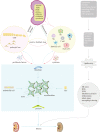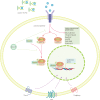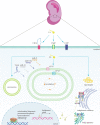Druggability of lipid metabolism modulation against renal fibrosis
- PMID: 33990764
- PMCID: PMC8888625
- DOI: 10.1038/s41401-021-00660-1
Druggability of lipid metabolism modulation against renal fibrosis
Abstract
Renal fibrosis contributes to progressive damage to renal structure and function. It is a common pathological process as chronic kidney disease develops into kidney failure, irrespective of diverse etiologies, and eventually leads to death. However, there are no effective drugs for renal fibrosis treatment at present. Lipid aggregation in the kidney and consequent lipotoxicity always accompany chronic kidney disease and fibrosis. Numerous studies have revealed that restoring the defective fatty acid oxidation in the kidney cells can mitigate renal fibrosis. Thus, it is an important strategy to reverse the dysfunctional lipid metabolism in the kidney, by targeting critical regulators of lipid metabolism. In this review, we highlight the potential "druggability" of lipid metabolism to ameliorate renal fibrosis and provide current pre-clinical evidence, exemplified by some representative druggable targets and several other metabolic regulators with anti-renal fibrosis roles. Then, we introduce the preliminary progress of noncoding RNAs as promising anti-renal fibrosis drug targets from the perspective of lipid metabolism. Finally, we discuss the prospects and deficiencies of drug targeting lipid reprogramming in the kidney.
Keywords: anti-renal fibrosis; drug targets; fatty acid oxidation; lipid metabolism; noncoding RNA.
© 2021. The Author(s), under exclusive licence to CPS and SIMM.
Conflict of interest statement
The authors declare no competing interests.
Figures




Similar articles
-
Inorganic nitrate and nitrite ameliorate kidney fibrosis by restoring lipid metabolism via dual regulation of AMP-activated protein kinase and the AKT-PGC1α pathway.Redox Biol. 2022 May;51:102266. doi: 10.1016/j.redox.2022.102266. Epub 2022 Feb 17. Redox Biol. 2022. PMID: 35217293 Free PMC article.
-
Nifedipine Exacerbates Lipogenesis in the Kidney via KIM-1, CD36, and SREBP Upregulation: Implications from an Animal Model for Human Study.Int J Mol Sci. 2020 Jun 19;21(12):4359. doi: 10.3390/ijms21124359. Int J Mol Sci. 2020. PMID: 32575412 Free PMC article.
-
Pre-emptive pharmacological inhibition of fatty acid-binding protein 4 attenuates kidney fibrosis by reprogramming tubular lipid metabolism.Cell Death Dis. 2021 Jun 3;12(6):572. doi: 10.1038/s41419-021-03850-1. Cell Death Dis. 2021. PMID: 34083513 Free PMC article.
-
Advances in energy metabolism in renal fibrosis.Life Sci. 2023 Jan 1;312:121033. doi: 10.1016/j.lfs.2022.121033. Epub 2022 Oct 19. Life Sci. 2023. PMID: 36270427 Review.
-
CD36 in chronic kidney disease: novel insights and therapeutic opportunities.Nat Rev Nephrol. 2017 Dec;13(12):769-781. doi: 10.1038/nrneph.2017.126. Epub 2017 Sep 18. Nat Rev Nephrol. 2017. PMID: 28919632 Review.
Cited by
-
The Therapeutic Potential of Zinc-Alpha2-Glycoprotein (AZGP1) in Fibrotic Kidney Disease.Int J Mol Sci. 2022 Jan 7;23(2):646. doi: 10.3390/ijms23020646. Int J Mol Sci. 2022. PMID: 35054830 Free PMC article.
-
Lipidomics reveals the potential mechanism of honokiol against adenine-induced chronic kidney disease.Front Pharmacol. 2022 Oct 14;13:1019629. doi: 10.3389/fphar.2022.1019629. eCollection 2022. Front Pharmacol. 2022. PMID: 36313325 Free PMC article.
-
The Mechanism of Plantaginis Semen in the Treatment of Diabetic Nephropathy based on Network Pharmacology and Molecular Docking Technology.Endocr Metab Immune Disord Drug Targets. 2024;24(3):363-379. doi: 10.2174/1871530323666230915100355. Endocr Metab Immune Disord Drug Targets. 2024. PMID: 37718520
-
Traditional Chinese Medicine targeting the TGF-β/Smad signaling pathway as a potential therapeutic strategy for renal fibrosis.Front Pharmacol. 2025 May 20;16:1513329. doi: 10.3389/fphar.2025.1513329. eCollection 2025. Front Pharmacol. 2025. PMID: 40463902 Free PMC article. Review.
-
Lipid metabolism disorders and albuminuria risk: insights from National Health and Nutrition Examination Survey 2001-2018 and Mendelian randomization analyses.Ren Fail. 2024 Dec;46(2):2420841. doi: 10.1080/0886022X.2024.2420841. Epub 2024 Nov 3. Ren Fail. 2024. PMID: 39491271 Free PMC article.
References
-
- Zhao X, Kwan JYY, Yip K, Liu PP, Liu FF. Targeting metabolic dysregulation for fibrosis therapy. Nat Rev Drug Discov. 2019:1–19:57–75. - PubMed
-
- Humphreys BD. Mechanisms of renal fibrosis. Annu Rev Physiol. 2018;80:309–26. - PubMed
-
- Chen DQ, Chen H, Chen L, Vaziri ND, Wang M, Li XR, et al. The link between phenotype and fatty acid metabolism in advanced chronic kidney disease. Nephrol Dial Transplant. 2017;32:1154–66. - PubMed
Publication types
MeSH terms
Substances
LinkOut - more resources
Full Text Sources
Other Literature Sources
Medical

